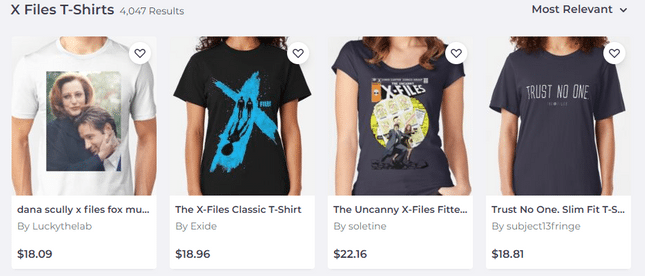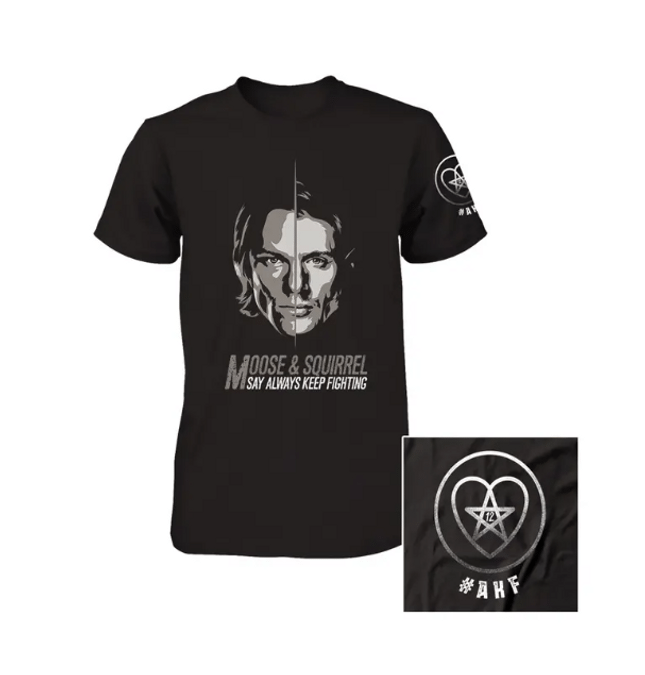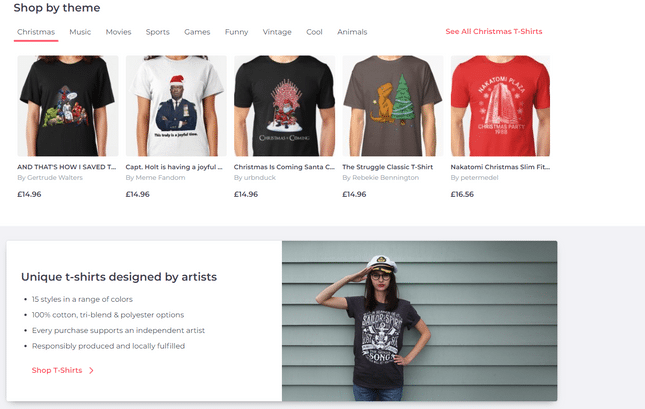How to Sell T-Shirts Online
If you click to purchase a product or service based on our independent recommendations and impartial reviews, we may receive a commission. Learn more
Design and Sell T-Shirts Online – 9 Must-Have Tips
You don’t need tech skills or tons of money to start an clothing online store, and this guide is going to show you how. We know getting started with any project can be daunting, so we’ll walk you through each step, from finding your target audience to copyrighting your genius t-shirt designs.
How To Sell T-Shirts Online – 9 Simple Steps
- Do Your Research
- Find Your Niche
- Start Designing
- Decide How to Sell Online
- Make Your T-Shirts Real
- Set Up Your Store
- Embrace Online Marketing
- Protect Your Designs
- Don’t Give Up!
We’ll go into more detail on each step, giving you helpful advice, tips, and dos and don’ts to help you set up your t-shirt business for success.
Find out more
- Looking to set up a website before getting started? Check out our Online Store Comparison Chart to find your perfect builder
Do Your Research
We know, this is the boring part. But it’s also a vitally important aspect of creating any successful online business – without research, you’ll struggle to find the right audience for your products, and might even be duplicating someone else’s ideas without realizing it!
There are three main areas where you need to carry out research – so grab a cup of coffee, sort yourself a snack, and get comfy.
1. Identify your target audience
First things first, you need to find out who you’re selling to. Who do you picture buying, wearing, and loving your t-shirts? (Clue: the answer shouldn’t be “everybody.”)
Narrowing down your target or ideal audience will help you with every step of designing and selling t-shirts online. So, how do you discover your target audience? Here are some tips:
- Think about your passions and interests, and who shares them
- Find brands that are doing something similar to your idea, and use their website, social media, and reviews pages to look at who makes up their main client-base
- Discover what people want – you could run surveys or interviews to learn more about who you’re targeting
Looking into these questions should quickly help you discover who you want to sell to – or at the very least, who you won’t be targeting, which is just as useful.

Gaining a good understanding of your target audience will help you:
- Decide on the best places to sell online (for example, how much to rely on social media)
- Choose the right language, tone of voice, colors, and branding to draw in customers
- Create products that sell by focussing and tailoring your designs to your audience
2. Competitor analysis
This might sound dry, but think of it more like something out of James Bond. You get to “spy” on your competitors, work out their strengths and flaws, and then use that information to make your own product and selling strategy even stronger.
Simply take to Google and start searching for brands which you think are targeting a similar audience, selling similar products to you, or dominating the t-shirt marketplace. Ask yourself:
- What are they doing right? Can I replicate this?
- What are they not doing well? How can I do better?
- Can I realistically compete with this brand? If not, how can I be different?
This will start to focus your ideas, and help make sure you’re carving out a unique space for yourself in the t-shirt industry.
3. Inspiration
The fun part! All the while you’re sneaking through competitors’ sites and browsing t-shirt designs, you should keep your eyes wide open for any inspiration. Whether it’s the t-shirts themselves, or even brand names, logos, or colors, you can get ideas for your own business during research.
Look out for:
- Design ideas
- Good use of color
- Examples of humor
- Customization options
- Best-selling patterns
You can then use these ideas to influence your own designs when it comes to creating and selling your t-shirts online.
- Identified your target audience
- Carried out some competitor research
- Had a look for some inspiration or new ideas
Find Your Niche
You’ve probably already realized that t-shirts are everywhere. From online marketplaces to city street corners, it seems everyone wants to sell you their designs – and if you don’t have a unique selling point, your products will get washed away in the t-shirt tide.
That’s why you need a niche.
From day one, you should be thinking about what sets you apart from all the other t-shirt sellers out there, and why people will want to buy your t-shirts instead of your competitors’ products. Don’t panic – we’re not talking about attaching jetpacks to tees or totally rethinking fashion. It can be much simpler than that!
A good place to start is to think about why you’re creating t-shirts. Aside from making money, what is it that made you google how to sell t-shirts online? Some people do it to raise money for charity, to raise awareness of mental health issues, or to express their love of a tv show, book, or film.

Here are some other things to think about:
- Pain points faced by your target audience – how could you address their needs?
- Are you jumping on a quick trend, or designing for the long-term?
- Do you have a unique angle? For example, the environmental impact of your t-shirts, or the story your designs tell?
It’s pretty clear that your niche ties closely to your target audience, so try to put them at the heart of your brand.
- Thought about what makes you different from your competitors
- Narrowed down your niche in the market
- Considered your target audience and how to connect with them
Find out more
- Need a helping hand? Our handy guide walks you through How to Find Your Niche Online from start to finish
Start Designing
Now’s the time to start designing your products. Maybe you started with this and already have tons of ideas, or maybe this is the first time you’ve sat down to think about what you actually want to create.
Either way, it’s time to get creative and turn those doodles into dollar-making designs!
1. Be creative
It seems like a simple enough tip, but don’t be afraid to embrace your inner designer and pick up a pen (or two, or three). Even if you haven’t done art since middle school, get your thoughts and ideas onto paper and get creative with colors, patterns, textures, and more. Mix things up!
2. Be original
This can be the hardest part of creating something new – making sure it actually is new!
There’s nothing wrong with using other brands for inspiration, as this can help you stay on-trend and help you out if you get stuck.
However, it pays to put your own stamp on your t-shirt designs and aim for a more unique product. This will help set you apart from competitors and build a more enthusiastic following, rather than restrict you to one-off orders.
3. Experiment
In the early days especially, don’t be afraid to experiment. Yes, you might get it wrong. Yes, people might hate your designs. That’s okay. You’ll learn from each one you put out, and grow both your confidence and your understanding of what does and doesn’t work.
4. Find your style
Maybe you’re naturally creative, maybe you’re not – you still need to find your style. Don’t panic, though – this doesn’t mean you need to spend years carefully crafting a unique drawing technique.
Instead, think about what ties your t-shirts together. For example, are they mostly white with black writing on them? If so, what font will you use? Why? Perhaps your t-shirts will feature cartoons or photos or abstract patterns – there should still be a certain something that makes them yours.

Here are some handy tools you might want to check out while designing your t-shirts:
- Canva – a simple, free tool that’s a great way for beginners to start putting designs together.
- Adobe Illustrator – commonly used by designers, this tool has a learning curve and comes with a price tag, but gives you great freedom and professional results.
- Inkscape – like a more basic version of Adobe Illustrator, Inkscape is a free vector graphics editor tool that’s pretty flexible, although not the easiest to use for beginners.
- Google Fonts – has a huge library of over 800 free and downloadable fonts for you to browse and use as you like.
- Coolors – if you’re struggling with choosing the right colors for your designs, this color scheme generator tool can help. It’s free, fun, and super easy to use!
If you don’t feel like taking on production, that’s okay too. If you have an idea, you can brief someone else to create your design. Sites such as Fiverr and 99designs are great resources for easily finding graphic design support for fair prices.
Find out more
- Planning to sell not only t-shirts online, but a wider range of merch, too? Explore our comprehensive guide to selling merchandise online for more info!
- Started designing your t-shirts
- Experimented with different styles and designs
- Tried out a few different tools to help you
Decide How to Sell Online
There are numerous ways to sell t-shirts online, so you need to find the option that works best for you.
1. Print-on-demand sites
Example sites: Redbubble, TeePublic, Spreadshirt
Best for: hobbyists and beginners testing out their first products
Good for you if: you’re just out to have some fun and make a little money at the same time
Print-on-demand sites let you create an account and upload your designs, which they then produce, sell, and ship for you. This makes them extremely popular with part-time sellers who don’t want to invest much effort and energy into their t-shirt side hustle.
The downside is that profits are pretty low, there’s a ton of competition, and you have little to no control over your brand or product.

2. Online marketplaces
Example sites: Amazon, Etsy, eBay
Best for: part-time sellers with some time and money, and an established customer base
Good for you if: you’re confident in your products’ ability to sell, but aren’t that confident with marketing
Online marketplaces bring the benefit of huge amounts of traffic, meaning more people will see your products and hopefully buy them. They’re popular with and trusted by consumers, and give you more control over your products.
One of the main hitches is that you still have very little control over building an actual brand or business identity with online marketplaces – and it can also be hard to build relationships with customers.
You can also encounter listing and sales fees, and are still subject to the whims of your chosen marketplace – if they change their algorithm, for example, your sales could suffer.
3. Online store builder
Example sites: Shopify, Wix, BigCommerce
Best for: beginners and pro sellers alike who want to build their business
Good for you if: you want control over your products and custom branding
Ecommerce builders like Shopify let you create your very own online store, without needing tech skills or tons of time and money. This means you can have all your products in one place, get total say over your branding and marketing, and build long-term relationships with customers.
Although it means more work – you’re in control of everything from shipping to customer care – you can automate a lot of the tasks to save you time and effort.
It’s also worth noting that with an online store builder, you can integrate selling across other platforms (such as Amazon, eBay, and Etsy), and use dropshipping services to remove the issues of storing and shipping your products.

Which Method Is Right For You?
Which selling option you choose will depend on your own needs and goals. Overall though, we recommend building an online store to sell t-shirts online. It’s suitable for both beginners and larger scale projects, gives you more room for growth, and is more professional than other methods.
Our top recommended ecommerce builders are:
- Shopify: Best for large t-shirt stores with complex inventories
- BigCommerce: Best for bulk selling t-shirts across multiple online channels – start your 15-day free trial today to get one month free when you pick your plan, as part of a limited-time offer
- Wix: Best for smaller t-shirt stores
- Squarespace: Best for small, brand-conscious t-shirt stores
Shopify can support complex inventories with multiple variants such as size and color – you can add up to 100 variants! BigCommerce is also great for larger stores, particularly multi-channel sellers. In contrast, Wix is best for small t-shirt stores, thanks to its simple inventory, and Squarespace is best for branding and marketing.
We carried out specific research into the best website builders for fashion stores, focussing especially on design and inventory management. You can compare their star ratings below, to see how each one performed in our research:
However, it really is up to you! Using a print-on-demand site can be a good tactic to start off with, followed by building your own online store. Using an online marketplace has its benefits, but can sometimes be more hassle than it’s worth.
- Looked into the different selling options available online
- Chosen the online selling method that best suits you
Find out more
- Unsure which ecommerce builder is best for you? Check out these reviews to help you decide:
- Shopify Review – find out why Shopify is our highest rated ecommerce builder
- Wix Ecommerce Review – discover why Wix is great for beginners, and what else it’s good at
- BigCommerce Review – get the lowdown on BigCommerce and its powerful selling tools
- Squarespace Ecommerce Review – decide whether Squarespace is the right choice for your store
Make Your T-Shirts Real
Once you’ve decided how you’ll be selling your t-shirts online, you’d better make sure you’ve got some real-life products to shout about!
This step will vary depending on which selling option you choose. If you’re using a print-on-demand service, for example, then all you need to do is upload your designs and they’ll take care of the rest.
However, if you’re in charge of managing your own products, you’ll need to think about a few of these things…
1. Sourcing your t-shirts
Do you want to provide high quality, durable t-shirts? Perhaps you live in a hot place where customers need light, airy fabric? Are you promoting an environmentally friendly product?
Sourcing t-shirts that match your brand’s values will help build a positive reputation and set you apart from lower quality products.

2. Printing your t-shirts
There are multiple different ways to print t-shirts, including:
- Direct-to-garment – cheap but slow, ink is applied straight onto fabric through an inkjet printer, providing a professional and detailed result; best for small orders
- Screen printing – uses layers of ink and stencils, making it a good option for bulk printing simple designs with only a few colors; it’s also very long lasting
- Heat transfer – a quick, easy, and cost-effective way of printing color images using heat transfer paper, this option is great for complex designs, but will crack or fade over time
Your choice should depend on the size of your orders, the complexity of the design, and the speed and cost you need the t-shirts to be produced at.
3. Storing and shipping
If you don’t have much storage space, or don’t want to deal with the ins and outs of couriers and shipping fees, you can use a fulfilment service, or choose a dropshipping service. These work in a fairly similar way, in that you don’t have to store or ship your products yourself.
If you choose to sell through Amazon, for example, you can pay to use its Amazon Fulfilment service, which takes care of storage, delivery, customer service, and returns handling. All you have to do is send Amazon your products.
Alternatively, you can choose dropshipping, where you forward (or “drop”) the details of your customer’s order to your dropshipping supplier, which then ships the product directly to the customer.
Both methods remove the need to store and ship products yourself – dropshipping involves less risk and investment, while fulfilment can serve a wider customer base and has better shipping services.

- Thought about what’s important to you when sourcing your t-shirts
- Decided the best way to print your t-shirts
- Looked at how you want to store and ship your t-shirts
Set Up Your Store
Now’s the time to get your products out there! Again, this will vary depending on the selling method you’ve chosen. We’ll briefly explore each one before moving on to promoting your products online.
But first, a quick look at the basic steps you need to take to get started:
- Take product photos – be thorough, use good lighting, only choose clear images, and don’t forget the back view!
- Write product descriptions – be specific, concise, descriptive and persuasive, and include all essential product information such as material, size, care details, and so on.
- Set prices – don’t undersell your products, but don’t scare people off with sky-high price tags either. Be consistent in your pricing, and make sure you take home some money!
Find out more
- Dicover How to Take Product Photos that impress visitors and boost sales in our helpful guide
- It’s not as easy as it looks… read our guide on How to Write Product Descriptions for some expert tips and tricks
- Unsure of how much to charge for your t-shirts? We’ve got your back – profit from our How to Price a Product guide
1. Set up your print-on-demand site
Simply create an account, upload your products, then sit back and relax!
2. Set up your online marketplace
Create a seller account, add your products, select your product category, and don’t forget to optimize your product listings with keywords to rank higher in search results.
3. Set up your online store
Set up an account, choose a template, and edit it until you’re happy with the look of your storefront. Then add products and get to grips with your settings, such as shipping options and stock level alerts, until everything is just how you want it. Click publish, and your store will be live on the internet!
- Taken product photos to put on your website
- Written persuasive product descriptions to tell people about your t-shirts
- Set realistic prices for each product
- Set up your store
Find out more
- Need help setting up your own online store? Head over to our in-depth guide on How to Build an Online Store next!
Embrace Online Marketing
So, your t-shirts are now up on the internet, just waiting for some lucky customer to come along and buy them. Your products wait… and they wait… and they wait… and sadly, that’s all they’ll do unless you embrace a bit of online marketing.
It’s true that print-on-demand sites and online marketplaces come with their own traffic, unlike shiny new online stores, but there are still things you can do to encourage sales.
1. SEO
Search Engine Optimization (SEO) is the art of helping your website rank highly in Google’s search results. If you’re building a new online store, SEO is your best friend – you want to be present on the first page of results to help people find your site.
Here are a few starter tips to be getting on with:
- Use keywords in headings, copy, and image file names
- Write descriptive alt text for images
- Link to other pages on your website
- Start a blog
- Use SSL security (this usually comes built-in to your builder anyway)
The list goes on and on!
Online marketplaces also have their own kind of SEO, where everyone is trying to get as high up in Amazon’s results (for example). The trouble here is that Amazon is also selling products itself, and usually ranks these above everybody else’s!
2. Social media
Take to your social channels and shout about your awesome t-shirts – but choose your channels wisely. Think about your target audience, and where they’re most likely to be browsing. Then, be careful and tactful in your shouting…
People turn to social media to relax and escape from the stress of daily life, so don’t stress your followers out by constantly pushing your products in their faces, yelling “Buy buy buy!” Instead, post relevant, regular, interesting content to build your brand name.

A great way to get people engaged is through user generated content – especially if your target audience is of a generation that loves sharing photos and getting likes! Simply ask customers to send in photos of themselves wearing your products, and offer rewards – even if it’s just posting the “winning” photo on your social media channels.
This is the perfect way of producing fun content while strengthening your social proof – showing that people are buying, enjoying, and promoting your products makes others more likely to buy!

3. Product reviews
Product reviews are hugely important when running an ecommerce business. It’s one of the reasons Amazon is so popular – it puts customer feedback at the forefront of its marketplace. The trouble is, this makes it difficult when you’re first starting out.
People want to see product reviews before they click buy, but nobody has bought anything yet to review, which means nobody will buy because there are no reviews… this vicious cycle can go on and on.
To get around this, try giving away freebies and seeking customer feedback, or partnering with a more well-known brand that can endorse your products. Offer small rewards for customers who rate and review their purchases, and try to gather testimonial quotes where you can.
- Optimized your products for getting found by customers
- Set up a professional social media account and started sharing content
- Put a plan in place to gather customer reviews and feedback
Protect Your Designs
A common question that gets asked when starting any kind of business is “What happens if someone steals my idea?”
We’ll outline some quick general advice, but now’s a good time for the disclaimer that we are not lawyers – so if you need real legal advice, please hire a professional!
Firstly, it may surprise you to know that as soon as you create a new design and put it down onto paper (or onto a t-shirt), it’s actually copyrighted as intellectual property. Even unregistered, you have legal rights over your creation, as long as it’s original and “fixed in a tangible form.”
However, it can be worth registering your designs for peace of mind, because it gives you a public record of ownership – and is essential if you ever need to act on someone else plagiarizing your work.
If you’re selling t-shirts online as a hobby or small side hustle, then it’s probably not worth the hassle of registering for copyright. However, if you’re setting up a business, then it’s likely better to be safe than sorry.
- Decided if you need to officially register for copyright
- Made sure your designs are eligible for copyright
- Applied to register your designs if suitable
Don’t Give Up!
Setting up a new business is always a bit scary. It’s important to remember that it might not go quite as planned from day one – and that these steps will be different for everyone.
The t-shirt market is pretty full, but that simply means everyone is waiting wide-eyed for the next big thing – so whatever happens, don’t give up!
Right at the start, we talked about looking for inspiration, experimenting, getting creative, and keeping an eye on both your target audience and your competitors. Don’t stop doing this. Put designs that aren’t right for now in a drawer for later, ask for feedback, and watch the trends.
Stick at it and keep on selling!
How to Sell T-Shirts Online: Summary
We’ve looked at the steps of how to sell t-shirts online, from the very first stages of researching and imagining, all the way through to the thrill of seeing your first orders rolling in.
We realize this is a pretty big guide, so don’t worry – you don’t have to tackle this all in one day. Save this page and come back to it whenever you feel like moving forwards with your t-shirt business, and enjoy every step!
How to Design and Sell T-Shirts Online: 9 Simple Steps
- Do Your Research
- Find Your Niche
- Start Designing
- Decide How to Sell Online
- Make Your T-Shirts Real
- Set Up Your Store
- Embrace Online Marketing
- Protect Your Designs
- Don’t Give Up!
There are so many different ways to go about selling t-shirts online. Our favorite method is to build your own online store using an ecommerce builder – we’ve researched this extensively, and our top recommendations for builders are:
- Shopify: try it free for 14 days
- BigCommerce: jump on its 15-day free trial
- Wix: try its editor for free before launching your store
- Squarespace: start creating with its 14-day free trial
Start off today by doing some research and deciding your goals – this will help you choose the best method of selling online later on. We hope this guide has got you excited about selling t-shirts online, and that you’ll come back and let us know how you get on!






2 comments